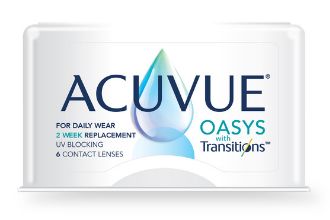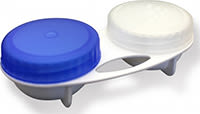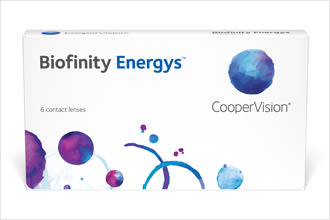What's new in contact lenses
FDA approves first contacts to slow myopia
November 2019— The U.S. Food and Drug Administration approved the first contact lens to slow the progression of myopia (nearsightedness) as an initial treatment for children ages 8-12.
CooperVision's MiSight contact lens is a single-use, disposable, soft contact lens not intended to be worn overnight.
Until now, traditional eyeglasses and contact lenses available in the U.S. have only been developed to correctblurred vision, a symptom of myopia, and not approved to slow its progression.
What is myopia?
爱游戏ayx官网 causes light rays to focus at a point in front of the retina rather than directly on the surface due to elongation of the eye.
Generally, myopia first occurs in school-age children and progresses until about age 20. According to a study published inClinical Ophthalmologyin August 2018, 41.9% of U.S. children ages 5-19 are myopic.
This is due in part to changing lifestyles, with children spending less time outdoors and more time focusing on close objects such as digital screens.
Myopic progression has been linked to sight-threatening conditions later in life such ascataracts,retinal detachmentandglaucoma.
Myopia contact lens research
TheFDA approval of MiSightwas based on data obtained from a prospective clinical trial at four clinical sites and real-world evidence. The safety and effectiveness of MiSight was studied in a three-year randomized, controlled clinical trial of 135 children ages 8-12 at the start of treatment who used MiSight or a conventional soft contact lens.
The trial showed that for the full three-year period, the progression in myopia of those wearing MiSight lenses was less than those wearing conventional soft contact lenses.
此外,受试者使用MiSight少change in the axial length of the eyeball at each annual checkup. Over the course of the trial, there were no serious ocular adverse events in either arm of the study.
The lens is already being successfully worn by thousands of myopic children in other parts of the world, including Canada, the United Kingdom, Spain and Australia, aCooperVision news releasenotes. Age ranges for initial fitting may vary around the world.
— Compiled from news releases
Contact lenses with antihistamines? They're being developed
April 2019— Allergy season can make your eyes itchy and red, and relief often comes in the form of eye drops. That presents challenges for contact lens wearers.
What if contact lenses were preloaded with an antihistamine to help reduce that itchiness caused by allergies?
Researchers at Johnson & Johnson Vision Care say single-use contact lenses that dispense the antihistamine ketotifen showed promising results in two Phase 3 clinical trials. Results of the study were published in the journalCorneain March.
Lead investigator Brian Pall, director of clinical science at Johnson & Johnson Vision Care, says antihistamine-dispensing lenses "look promising in their ability to reduce eye itch."
Why put antihistamines in contacts? "Eye drops are contraindicated for contact lens wearers," Pall says. The itchiness caused by allergies leads the contact lens wearer to rub his or her eyes, possibly damaging the lenses.
戴隐形眼镜的使用者现在必须拿出他们的帐目cts, apply eye drops and then switch to glasses until the antihistamine takes effect.
A contact lens with the antihistamine built in would "address lifestyle needs," Pall says.
Thestudiesfound a significant reduction in eye itching 15 minutes after inserting the lenses with antihistamines and the that this relief lasted for the 12-hour study period.
How does the contact lens work? The antihistamine is embedded in the lens material and it is released over time and delivered to the surface of the eye, Pall says.
How soon might antihistamine-dispensing contact lenses be an option for allergy relief? It's too early to tell, but Pall says Johnson & Johnson is preparing the regulatory submissions for approval.
— By Jeff Herman
Oasys with Transitions contact lenses debut
Some eyeglass lenses darken automatically in sunlight to reduce glare and help you see more comfortably in bright light. Now the samephotochromic technologyis available in Acuvue Oasys contact lenses.
Acuvue parent company Johnson & Johnson Vision and Transitions Optical have teamed up to produce the first light-adaptive contact lenses. The collaboration between the two teams of researchers began about a decade ago.

"We had to overcome a huge technology hurdle to make this happen," David Turner, head of contact lens research and development at Johnson & Johnson Vision, told Time magazine. Acuvue Oasys with Transitions was named one of Time's "Best Inventions of 2018."
The two-week disposable lenses also block the sun's harmful UV rays and prevent potentially damagingblue lightfrom entering the eye.
Johnson & Johnson Vision received 510(k) clearance for the photochromic contact lenses from the U.S. Food and Drug Administration in April 2018. Health Canada granted a medical device license for the photochromic contact lenses in October.
Acuvue Oasys with Transitions launched in the U.S. and Canada on April 1.
— By Jeff Herman
Boston scleral contact lens case introduced
Spring/Summer 2018 —A storage case sized for scleral lenses has received FDA approval, said manufacturer Bausch + Lomb.

The case holds lenses that are up to 23.5 millimeters in diameter and up to 10 millimeters in sagittal depth.
Custom-made scleral lenses are larger than other contact lenses, and people who use them often don't have an appropriately sized storage container for them.
The new Boston-branded case is available from the Bausch + Lomb Specialty Vision Products Web Store.
5 things you can do to avoid an eye infection during spring break
All About Vision is partnering with the CDC to make sure contact lens wearers keep their eyes healthy during spring break time.
Did you know that teens and young adults have an increased risk of contact lens-related eye infection because of poor hygiene habits? If you want to keep an infection from ruining your vacation time, follow these tips:

Contact lens wearers: Don't spoil your spring break with an eye infection!
Take your contact lenses out before you sleep, even when up late or traveling (unless your eye care provider tells you otherwise).
Never top off your lens solution, or add new solution to old solution in the contact case to store lenses.
Bring enough contact lens supplies and a spare pair of glasses with you when traveling.
Never swim or shower in contact lenses.
All contact lenses require a prescription from an eye care provider. Never buy decorative contact lenses from illegal vendors.
As the weather gets nicer, more people will be cooling off with pool time. Always remember to take your contact lenses out, or wear goggles before jumping in. Water from pools, rivers, lakes and the ocean can introduce harmful germs into your eyes. Contact lenses can trap these germs and lead to serious infections.
Also, if you plan on staying out late, you should pack your contact lens supplies and always take them out before sleeping. A backup pair of eyeglasses is a great idea, too.
For more information from the CDC on contact lens health, visit www.cdc.gov/contactlenses.
Bausch + Lomb launches contact lens recycling program
Winter 2016 —Did you know? Normally, used blister packs, top foil and contact lenses are not recyclable locally. Usually they are filtered out and sent to landfills instead.
But if you're a wearer, there's great news: The new Bausch + Lomb #OneByOne recycling program lets you recycle your used lenses, blister packs and top foil, free of charge.

Contact lens wearers can help keep our planet beautiful by recycling their lenses and packaging — free!
And that's true whether you wear Bausch + Lomb Biotrue Oneday lenses, other Bausch + Lomb brands or any other contact lens brand.
If keeping Mother Earth cleaner isn't enough motivation for you, for all recycled materials received, Bausch + Lomb is donating to the eye care charitable organization Optometry Giving Sight.
The program was developed in partnership with TerraCycle, a company that collects and repurposes hard-to-recycle post-consumer waste.
How does it work? Simply place your used blister packs, top foil and contact lenses into a small cardboard box. When the box is full, print a free One by One shipping label, available at BauschRecycles.com. Take the box to a UPS location or ship it from your home or office. That's all you have to do!
(Note: Don't include the outer boxes of your contact lens packaging. These can be placed with other cardboard that you normally recycle locally.)
SEE RELATED:Don't flush contact lenses. Recycle them.
Biofinity Energys contacts address symptoms of digital eye strain
Summer 2016 —CooperVision公司推出了Biofinity能源to help the millions of digital device users deal with discomfort associated with long hours of screen use. Discomfort is characterized by tiredness, dryness and redness.

This monthly-replacement contact lens is designed to help digital device users' eyes feel less fatigued.
Biofinity Energys is designed for all-day wear and uses a two-fold approach to combat device-induced discomfort: Multiple front-surface aspheric curves across the entire optical zone simulate positive power in the center of the lens, which helps reduce strain on eye muscles as a wearer's gaze repeatedly moves from screen to off-screen and back.
In addition to this optimized lens design, the company's Aquaform Technology is said to attract and bind water throughout the lens material. This serves to retain moisture even during times of reduced blinking, which is common with screen use.
After one week of wear, eight of ten digital device users agreed that Biofinity Energys lenses made their eyes feel less tired, according to CooperVision. The lens is designed for monthly replacement, and a phased rollout for the United States begins in July.
Page updated May 2018


